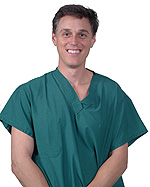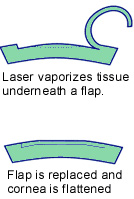|
Understanding
that there are a wide variety of ways to deal with
refractive errors (blurry vision caused by misaligned or
distorted optical elements of the eye, not by an organic
disease process) namely eyeglasses and contact lenses, one
must understand that these are merely corrections for the
problem not cures. For those who are interested in a cure
for their refractive error the discussion then turns to
refractive surgery. The aforementioned LASIK is such a
procedure. At Teagle Optometry, we are advocates for the
LASIK procedure as a viable alternative to eyeglasses or
contact lenses. Since 1995 Refractive Surgery has been
performed on hundreds of our patients with very positive
results. We believe that the right technique, performed by
the right surgeon, using the most current technology in
equipment and technique will yield the most desired result.
That is permanent, long lasting, trouble free clear vision.
Currently, LASIK is effective at curing distance vision
problems only; it cannot correct the "over 40" need for
reading glasses without negatively effecting the distance
vision. So as you can imagine, not all refractive error
patients will benefit from having the LASIK procedure
performed on their eyes. So how do you know if LASIK is
right for you? Read on...
At Teagle Optometry, we do not perform LASIK surgery. Our
role in the treatment is to provide council and select good
patients for LASIK, to provide pre- and post-op care, and to
make sure our patients find the right doctor. We looked long
and hard to find a surgeon we felt was good enough to
entrust our LASIK patients to. That person is Dr. Brad
Elkins from Ophthalmology Associates of the Valley (see
below).
If you are
interested in how refractive surgery can fit into curing
your blurry vision, we would be pleased to perform a free
refractive surgery consultation to explore what LASIK can or
cannot do for you. Please send us an e-mail request or call
our office at 661-253-3888 to schedule your appointment today.

Brad
S. Elkins MD
No
matter how many LASIK
procedures he performs,
Dr.
Elkins says he never tires
of seeing his patient's
enthusiastic reactions to
their results. |
 |
Ophthalmology Associates of the Valley
16311 Ventura Boulevard Suite 750
Encino, CA 91436
http://www.oaveyes.com |
Dr. Brad Elkins not only
specializes in laser vision correction, but he has
also had the procedure himself. In 1996, Dr. Elkins
became one of the few Fellowship trained refractive
surgeons in the country. Dr. Elkins was the first
ophthalmologist to perform LASIK in the San Fernando
Valley. He has performed over 5,000 LASIK
procedures. Of these, over 2,000 have been performed
with Intralase.
Dr. Elkins graduated Phi Beta Kappa and Summa Cum
Laude from UCLA, and he graduated with honors from
UC San Francisco School of Medicine. He completed
his internship at UCLA and took his residency in
ophthalmology at the famed Jules Stein Eye Institute
at UCLA. From there, he completed a fellowship in
cornea and refractive surgery at the University of
Utah.
He has been a Physician instructor for numerous
LASIK, ALK and RK courses. Today, Dr. Elkins
frequently lectures to other physicians on the fine
points of refractive surgery. Furthermore, he has
authored numerous articles on advanced cataract
surgery, corneal transplantation and laser
refractive surgery. |
back to
top
|
 |
What
is LASIK Surgery?
LASIK is an acronym for
Laser Assisted in Situ Keratomileusis. LASIK is
essentially a combination procedure using an
instrument known as a
microkeratome and the laser surgery (PRK)
to correct for focusing problems in the eye.
In LASIK a flap is created in the cornea using a
special microsurgical blade (microkeratome). The
excimer laser is then used to remove a microscopic
layer of tissue from the deeper layer of the cornea
to correct the refractive problem. After the excimer
laser reshapes the cornea the flap of tissue created
by the microkeratome is then repositioned on the top
surface of the eye and adheres strongly after a few
minutes without sutures. This is in contrast to
surface PRK where the tissue removed is from the
surface of the cornea. LASIK is the most common type
of laser vision correction today. |
How
LASIK Corrects your Focusing Problems:
If you are myopic (nearsighted) the laser
phase of your LASIK treatment reduces the curvature of your
cornea to focus light on to the retina.
If you are hyperopic (farsighted) the laser
phase of your LASIK treatment increases the curvature of the
cornea to focus light on to the retina.
If you have astigmatism the PRK laser of your LASIK
treatment selectively alters the curvature of the cornea so
that the light is focused at a point on the retina rather
than 2 focal lines.
Who Qualifies for LASIK?
>
Have stable vision for at least 1 year prior
to the time of surgery.
>
Have a full eye examination to rule out
conditions that may contraindicate LASIK surgery.
>
Have a refractive problem within the range of
effective treatment.
>
Be fully informed of the benefits and possible
complications following LASIK surgery.
>
Not currently taking certain medications
which may be contraindications to LASIK surgery (notably
Accutane &
Amiodarone).
After LASIK:
Your flaps will be re-evaluated immediately after the
treatment is completed. You are then sent to the patient
lounge for 30 minutes to rest and allow your eyes to settle.
A surgical assistant will go over the eye drops and post
operative instructions with you. After 30 minutes your flaps
will be re-checked and you are then free to leave the
office. You will be advised to take it easy for the
remainder of the day. Your vision for the first 12-18 hours
immediately after LASIK will be fuzzy, similar to looking
through wax paper. When you wake up the following morning
your vision will be very good.
The Benefits of LASIK
Surgery:
>
Rapid recovery of good vision. The epithelium is relatively
untouched in the visual axis.
> Minimal discomfort lasting
only for 1 day.
> Less tendency of haze
formation than in surface PRK.
> Less tendency to regress.
> Reduced frequency of post-op
eye drops.
> Reduced frequency of follow
up visits.
> A patient who has had a
successful LASIK procedure appreciates these advantages.
back to
top
|